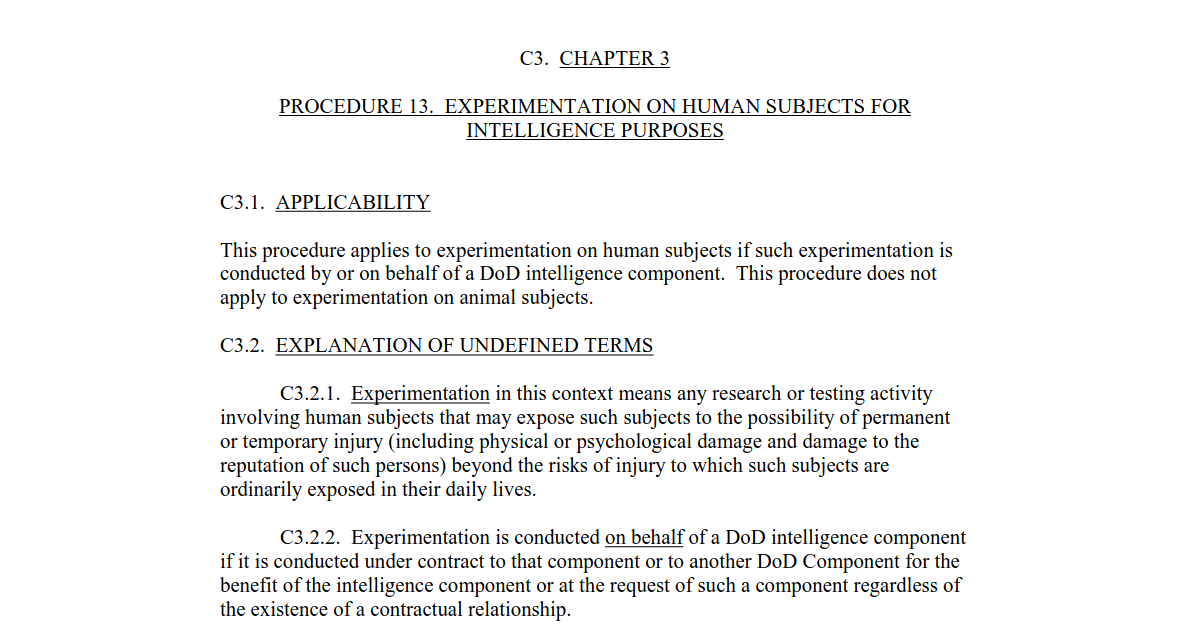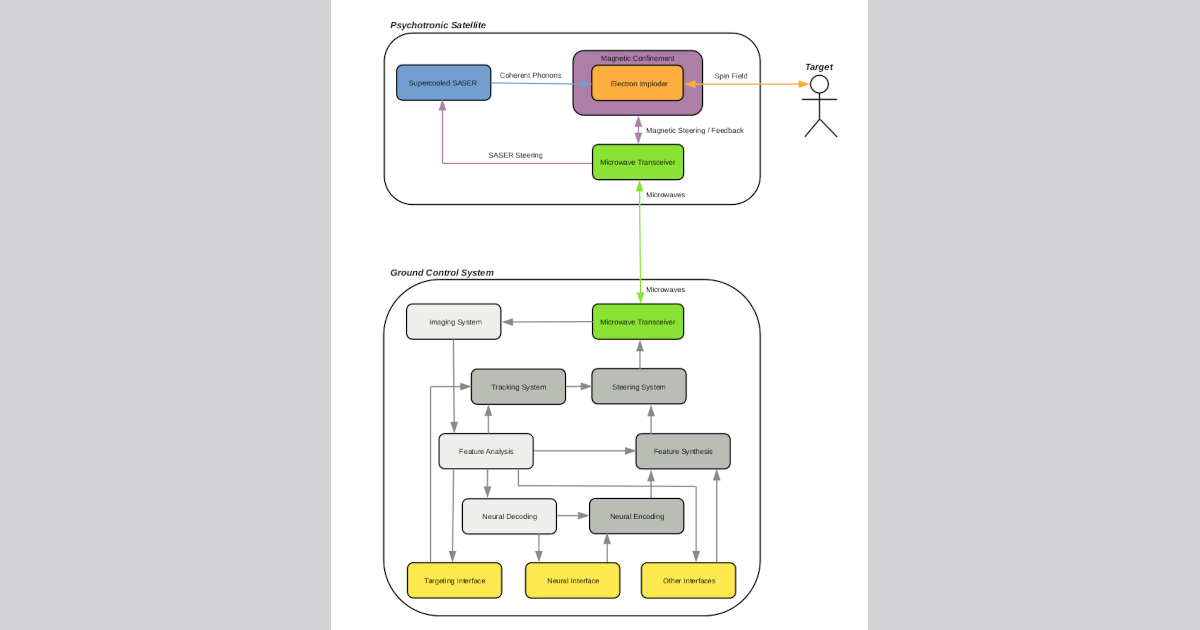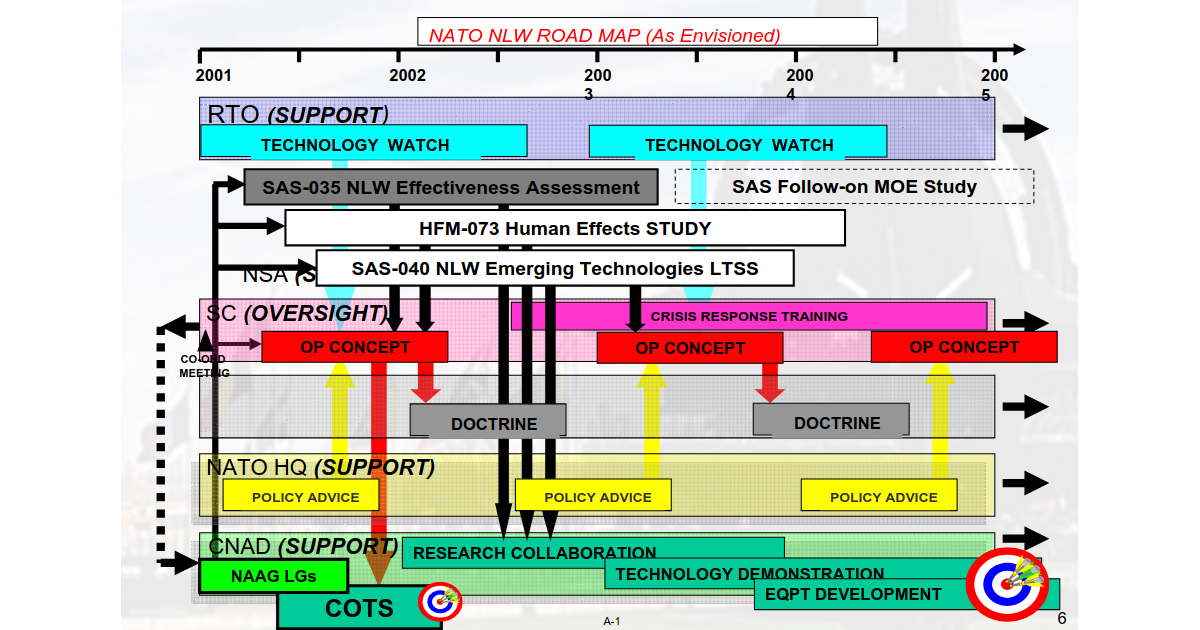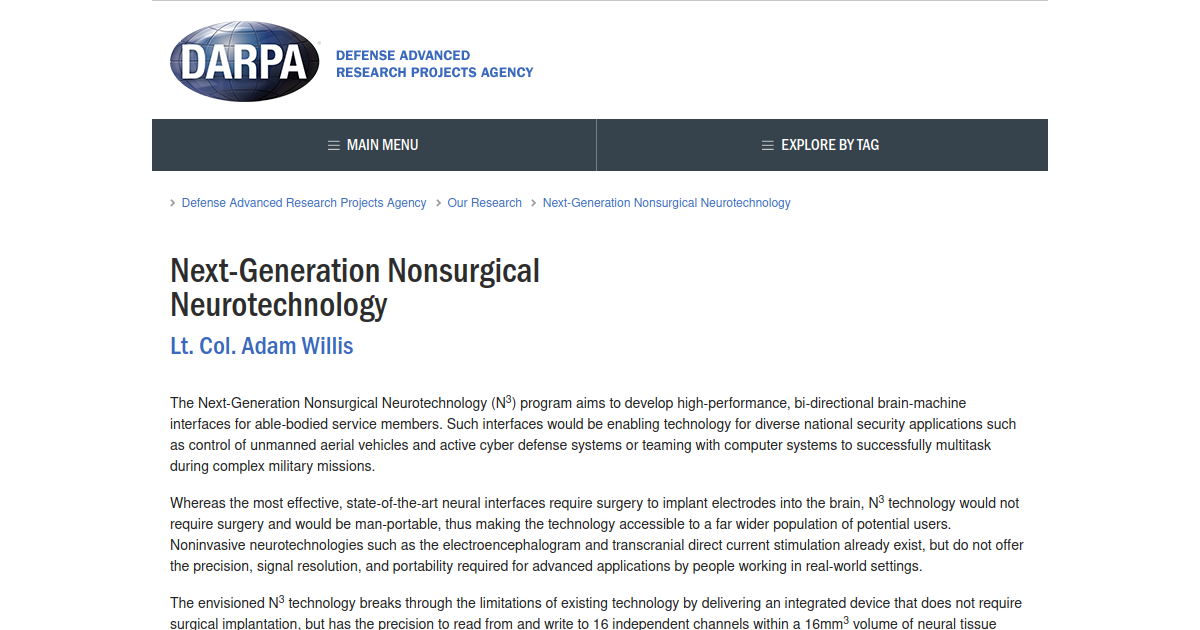PROCEDURES GOVERNING THE ACTIVITIES OF DOD INTELLIGENCE COMPONENTS THAT AFFECT UNITED STATES PERSONS
UNDER SECRETARY OF DEFENSE FOR POLICY
DECEMBER 1982
https://nsarchive2.gwu.edu/NSAEBB/NSAEBB230/01.pdf
DOD DIRECTIVE 5148.13
INTELLIGENCE OVERSIGHT
Office of the Deputy Chief Management Officer of the Department of Defense
26 April 2017
https://dodsioo.defense.gov/Portals/46/DoDD%205148.13%20Intel%20Oversight.pdf?ver=WkcaGoXFLCofrt77nEC8AA==
PROCEDURES GOVERNING THE ACTIVITIES OF DOD INTELLIGENCE COMPONENTS THAT AFFECT UNITED STATES PERSONS
DECEMBER 1982 Incorporating Change 2, Effective April 26, 2017 (see DoD Directive 5148.13)
UNDER SECRETARY OF DEFENSE FOR POLICY
https://www.esd.whs.mil/Portals/54/Documents/DD/issuances/dodm/524001r.pdf?ver=2dAiRj-ziUg52FWzLj6M5Q%3D%3D
Related:
HUMAN USE REQUIREMENTS
https://www.cia.gov/readingroom/docs/CIA-RDP96-00788R001500140006-6.pdf
Intelligence Oversight Policy Guidance
26 March 2008
https://dodsioo.defense.gov/Portals/46/Documents/DTM-08-011.pdf
DOD MANUAL 5240.01
PROCEDURES GOVERNING THE CONDUCT OF DOD INTELLIGENCE ACTIVITIES
Office of the Deputy Chief Management Officer of the Department of Defense
8 August 2016
https://dodsioo.defense.gov/Portals/46/DoDM%20%205240.01.pdf
Agreement between the Government of the Kingdom of the Netherlands and the Government of the United States of America establishing a Framework for Defense Cooperation Activities
Verdrag tussen de Regering van het Koninkrijk der Nederlanden en de Regering van de Verenigde Staten van Amerika inzake de totstandkoming van een raamwerk voor samenwerking op het gebied van defensieaangelegenheden
2018, Washington
https://wetten.overheid.nl/BWBV0006756/2020-11-01
From this document:
This Agreement provides a framework to facilitate defense cooperation activities. Such defense cooperation activities may include, but are not limited to the following:
…
– Research, development, testing, and evaluation;
Agreement between the Government of the Kingdom of the Netherlands and the Government of the United States of America on cooperation in science and technology concerning homeland and civil security matters
Verdrag tussen de regering van het Koninkrijk der Nederlanden en de regering van de Verenigde Staten van Amerika inzake wetenschappelijke en technologische samenwerking betreffende nationale en civiele veiligheid
29 November 2012, Washington
https://wetten.overheid.nl/BWBV0006073/2016-04-01
From this document:
Cooperative Activities may include the following:
…
g) joint use of laboratory facilities and Equipment and Material, for conducting scientific and technological activities including research, development, testing and evaluation;
h) use and optimization of existing technologies for defense against terrorism, natural disasters, and other homeland/civil security threats;
i) testing and evaluation of specific prototype systems for homeland/civil security applications in both laboratory environments and real or simulated operational settings. This includes technologies associated with enhanced detection and monitoring of potential terrorist activities and those associated with recovery and reconstitution of damaged or compromised systems;
BIOLOGICAL EFFECTS OF DIRECTED ENERGY
UNITED STATES AIR FORCE RESEARCH LABORATORY
AFRL-HE-BR-TR-2002-0226
Thomas Dayton, Charles Beason, et al.
November 2002
https://apps.dtic.mil/sti/tr/pdf/ADA408809.pdf
Nonlethal Weapons and Capabilities
Council on Foreign Relations
2004
https://cdn.cfr.org/sites/default/files/report_pdf/Nonlethal_TF.pdf
From this document:
P.13. Since 1997, the Joint Nonlethal Weapons Directorate (JNLWD) has had the responsibility for developing, testing, standardizing, and preparing for procurement these types of tactical capabilities. Most recently, they have been incorporated in nonlethal capability sets (NLCS), of which some 18 exist in the U.S. Army and some 50 in the Marine Corps.
P.17. In addition, the JNLWD provides complex and expensive human effects testing services for both the military and the greater NLW user community, including law enforcement groups.To the extent that NLW will be used on mixed combatant and civilian groups, it is important to understand their effects on children as well as adults.
Joint Non-Lethal Weapons Directorate Critical Support Services Performance Work Statement
JNLWD Critical Support Services PWS
Solicitation M67854-20-F-3008
v1.3
https://www.marcorsyscom.marines.mil/About-Us/Office-of-the-Counsel-OC/FOIA-Reading-Room/FileId/179506
From this document, HE = Human Effects, NL = Non-Lethal:
4.2 HE Scientist. The Contractor shall provide one on-site, full time, senior HE scientist and one part-time, off-site junior HE scientist to provide technical and research management activities supporting physical, biological, behavioral, and scientific principles related to bio-effects of NL weapons stimuli—blunt trauma, human electro-muscular incapacitation, directed energy effects, and related other impacts. The HE scientist must be able to communicate complex concepts to a wide range of audiences and conduct day-to-day administrative tasks and other activities associated with the normal operation of the JNLWD HE team. The HE Scientist will resolve difficult technical/bio-effects problems and issues, as well as plan, design, monitor and evaluate complex non-lethal weapons HE and NLW effectiveness programs and projects.
Department of Defense
DIRECTIVE
NUMBER 3000.03E
April 25, 2013
Incorporating Change 2, August 31, 2018
USD(A&S)
SUBJECT: DoD Executive Agent for Non-Lethal Weapons (NLW), and NLW Policy
https://www.esd.whs.mil/Portals/54/Documents/DD/issuances/dodd/300003p.pdf?ver=2017-09-27-
From this document:
- POLICY. It is DoD policy that:
f. Developers of NLW will conduct a thorough human effects characterization in accordance
with DoD Instruction (DoDI) 3200.19 (Reference (e)) to help understand the full range of effects
and limitations prior to operational employment of the NLW
Department of Defense
INSTRUCTION
NUMBER 3200.12
August 22, 2013
Incorporating Change 3, Effective December 17, 2018
SUBJECT: DoD Scientific and Technical Information Program (STIP)
https://www.esd.whs.mil/Portals/54/Documents/DD/issuances/dodi/320012p.pdf
Department of Defense
INSTRUCTION
NUMBER 3200.19
May 17, 2012
Incorporating Change 2, August 31, 2018
USD(A&S)
SUBJECT: Non-Lethal Weapons (NLW) Human Effects Characterization
https://www.esd.whs.mil/Portals/54/Documents/DD/issuances/dodi/320019p.pdf?ver=2019-04-16-084248-833
From this document:
e. NLW programs that involve human subjects shall comply with DoD Instruction 3216.02
(Reference (f)) and implementing DoD Component issuances.
DOD INSTRUCTION 3216.02
PROTECTION OF HUMAN SUBJECTS AND ADHERENCE TO ETHICAL STANDARDS IN DO D-CONDUCTED AND -SUPPORTED RESEARCH
Originating Component: Office of the Under Secretary of Defense for Research and Engineering
Effective: April 15, 2020
Change 1 Effective: June 29, 2022
https://www.esd.whs.mil/portals/54/documents/dd/issuances/dodi/321602p.pdf
From this document:
3.8. SELECTION OF HUMAN SUBJECTS AND EVALUATING RISK.
…
3.11. UNIQUE DOD LIMITATIONS ON WAIVER OF INFORMED CONSENT.
a. Sections 219.116(e) and (f) of Title 32, CFR, identify conditions where an IRB may waive
informed consent for DoD-conducted and DoD-supported HSR.
b. Section 980 of Title 10, U.S.C.:
(1) Imposes limitations on waiving informed consent when DoD appropriated funds are
used to finance the research.
(2) Is applicable only to DoD-conducted and DoD-supported research when involving a
human being as an experimental subject as defined in this issuance. Research involving a human
being as an experimental subject, governed by Section 980 of Title 10, U.S.C., is a subset of
research involving human subjects, regulated by Title 32, CFR.
(3) Is not applicable to exempt HSR.
c. For research involving a human being as an experimental subject to which Section 980 of
Title 10, U.S.C., applies, informed consent must be obtained in advance from the experimental
subject or the subject’s legal representative (consistent with Part 219 of Title 32, CFR, if the
subject cannot consent). If consent is obtained from the subject’s legal representative, the
intention of the key investigator must be for the research to be beneficial to the subject.
d. For research governed by Section 980 of Title 10, U.S.C., that involves no more than
minimal risk, as defined by Part 219 of Title 32, CFR, an IRB may alter or waive other required
elements of informed consent pursuant to Part 219 of Title 32, CFR, so long as it still preserves
informed consent of the subject (i.e., the consent indicates the subject’s participation in the
research is completely voluntary and includes the requirement that the subject is informed of
research risks).
e. The advance informed consent requirement pursuant to Section 980 of Title 10, U.S.C.,
may be waived by the DOHRP or its delegate, if the following conditions are met:
(1) The research is to advance the development of a medical product necessary to the
DoD.
(2) The research may directly benefit the individual experimental subject.
(3) The research is conducted in compliance with all other applicable laws and
regulations.
H.R.2401 – National Defense Authorization Act for Fiscal Year 1994
https://www.congress.gov/bill/103rd-congress/house-bill/2401/text
10 USC 980: Limitation on use of humans as experimental subjects
https://uscode.house.gov/view.xhtml?req=granuleid:USC-prelim-title10-section980&num=0&edition=prelim
From this document:
(a) Funds appropriated to the Department of Defense may not be used for research involving a human being as an experimental subject unless-
(1) the informed consent of the subject is obtained in advance; or
(2) in the case of research intended to be beneficial to the subject, the informed consent of the subject or a legal representative of the subject is obtained in advance.
(b)(1) The Secretary of Defense may waive the prohibition in this section with respect to a specific research project to advance the development of a medical product necessary to the armed forces if the research project may directly benefit the subject and is carried out in accordance with all other applicable laws.
(2) The Secretary may delegate the authority provided by paragraph (1) to the Under Secretary of Defense for Research and Engineering.
Related:
EFFECTIVENESS TEST and EVALUATION of Non-lethal Weapons in Crowd Scenarios: METRICS, MEASURES, AND DESIGN OF EXPERIMENTS
Elizabeth Mezzacappa, Gordon Cooke, Robert M. DeMarco, Gladstone V. Reid, Kevin Tevis, Charles Sheridan, Kenneth R. Short, Nasir Jaffery, and John B. Riedener
https://www.dau.edu/sites/default/files/Migrate/ARJFiles/ARJ82/ARJ82_Article%206%20-%2016-768%20Mezzacappa.pdf
From this document:
Institutional review boards forbid live-fire NLW testing.
Readers might argue that NLW cannot be tested and evaluated through live-fire. They might protest that because of the ethical issues of targeting people with real NLW, Institutional Review Boards (IRB) and Human Research Protection Offices will refuse to review and approve NLW protocols.
While it is beyond the scope of this article to fully discuss the IRB issues relevant to NLW, a short response to that statement is that the statement is not true. Experiments using NLW fires against intended human targets can be proposed to, and approved by, IRBs if the risks of the experiment to the subjects are outweighed by the scientific benefits from the study. This approval can be possible only if:
(a) a complete set of safety data is available for the NLW,
(b) risks to targets are fully described,
(c) risks are properly mitigated within the research procedures,
(d) all risks are fully and clearly described to potential subjects, and
(e) subjects’ consent to participate are freely given.
Resistance on the part of IRBs has not been the real obstacle to NLW effectiveness research. Rather, we have found in our decade-long experience, the difficulty in running live-fire NLW testing is the inability to receive from vendors comprehensive safety data. Without complete risk data, investigators cannot: (a) present to potential subjects a complete description of the risks they will be accepting with exposure to the NLW, and (b) properly mitigate the risks. It is this lack of safety data, not a lack of safety, that renders NLW experimentation unacceptable to IRBs. When IRBs can ensure that all relevant information can be presented to a subject for consideration, and that risks are adequately mitigated, then IRBs can approve live-fire testing with NLW.
DoD Non-Lethal Capabilities: Enhancing Readiness for Crisis Response
U.S. Department of Defense
Non-Lethal Weapons Program
Annual Review, 2015
https://defenseinnovationmarketplace.dtic.mil/wp-content/uploads/2018/02/2015_DoD_NLWP_ANNUAL_REVIEW.pdf
From this document:
Human Effects’ Critical Role in Non-Lethal Systems Acquisition
At the center of nearly every effort to develop and field non-lethal capabilities is the need for a thorough understanding of effectiveness and risk of injury. While counter-personnel capabilities have obvious needs for this type of analysis, counter-materiel capabilities often require substantial human effects analysis as well.
The DoD Non-Lethal Weapons Program coordinates these much-needed research efforts using subject matter experts throughout the acquisition process—ending in a fielded non-lethal capability with well-understood injury risks.
The Department of Defense Instruction 3200.19 addresses the framework through which human effects experts support non-lethal weapons development. The instruction requires system developers to identify effectiveness and risk of significant injury for all non-lethal weapons.
As a part of this effort, the DoD Non-Lethal Weapons Program links developers and program managers with human effects experts to guide the process. In particular, the Program’s sponsored Human Effects Review Board provides program managers and other key stakeholders with a peer-reviewed assessment of a capability’s human effects data, potential human effects risks, and recommendations for further study. The Human Effects Review Board is an independent group of DoD medical and safety officers from each of the Services and is chaired by the Joint Non-Lethal Weapons Directorate’s Human
Effects Officer.
NATO STO Technical Reports
https://www.sto.nato.int/publications/STO%20Technical%20Reports/Forms/All%20Documents.aspx
NATO and Intermediate Force Capabilities: Why Human Effects Matter
Shannon Foley,1 Caitlin Jackson,1 Susan Aros,2 and Anne Marie Baylouny 2
Connections QJ 21, no. 2 (2022): 123-134
https://doi.org/10.11610/Connections.21.2.09
https://connections-qj.org/system/files/21.2.09_ifc_human_f.pdf
OFFICE OF THE UNDER SECRETARY OF DEFENSE FOR RESEARCH AND ENGINEERING
https://www.cto.mil
The Office of the Director, Operational Test and Evaluation
https://www.dote.osd.mil
711 HPW – Institutional Review Board
The mission of the Air Force Research Laboratory’s Institutional Review Board (IRB) is to facilitate excellence in human-performance and technological research that advances warfighting capabilities in air, space, and cyberspace by efficiently processing and professionally evaluating proposals for scientific validity and uncompromising protection of the rights and welfare of volunteer subjects.
Investigators should visit the Information Center Page (CAC required) to download submission templates and review processes for submission of protocols. They should also review applicable Regulations, including the most recent versions of AFI 40-102 Protection of Human Subjects and Adherence to Ethical Standards in Air Force Supported Research and AFRLI 40-102 Protection of Human Subjects in Research, both of which were substantially rewritten in the latter half of 2014.
All primary investigators, associate investigators, and other key personnel engaged in AFRL-supported human-subject research must have completed the AFRL-designated annual required training found on ADLS (for Government Civilians and Military Personnel) and every three years complete the modules hosted by the Collaborative Institutional Training Initiative (CITI).
CONTACT THE IRB MAIN OFFICE:
AFRL IRB
711 HPW/IR
2245 Monahan Way, Bldg 29, Rm 201
Wright-Patterson AFB, OH 45433
Intramural submissions: AFRL.IR.PROTOCOLMANAGEMENT@us.af.mil
Extramural submissions: AFRL.IR.HRPO@us.af.mil
EXTRAMURAL DOCUMENTS
- INSTRUCTIONS – Extramural Submission Instructions
- CHECKLIST – Extramural Initial Submission Checklist
- INFO SHEET – DoD Supported Human Subjects Research
IRB REGULATIONS
10 USC 980 – Limitations On Use Of Humans as Experimental Subjects
21 CFR 50 – Protection of Human Subjects
21 CFR 56 – Protection of Human Subjects
32 CFR 219 – Protection of Human Subjects
AFI 40-402 – Protection of Human Subjects and Adherence to Ethical Standards in DAF-conducted and DAF-supported Research
AFRLI 40-402 – Using Human Subjects in Research
DoD 5400.11-R – Department of Defense Privacy Program
DoD 6025.18-R – DoD Health Information Privacy Regulation
DoD 3216.02 – Protection of Human Subjects and Adherence to Ethical Standards in DoD-conducted and DoD-supported Research
Live Fire Test and Evaluation (LFT&E)
Y18 LFT&E PROGRAM – Live Fire Test and Evaluation (LFT&E)

Related:
T&E WIPT: T&E Working-level Integrated Product Team
TEST AND EVALUATION ENTERPRISE GUIDEBOOK
This page is a work in progress …



